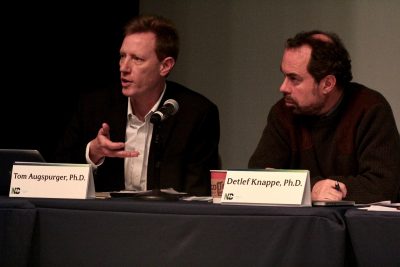
WILMINGTON – After a three-hour set of briefings, numerous questions and a discussion of next steps, a 16-member state science panel this week approved a plan to deal with some of the thornier issues rising from the release of studies showing elevated levels of GenX in the Cape Fear River and the drinking water drawn from it. Two of the biggest issues are establishing what’s known about the compound and then effectively communicating its health risks to the public.
During a meeting Monday at University of North Carolina Wilmington, the Secretary’s Science Advisory Board on Toxic Air Pollutants, which is made up of toxicologists, environmental scientists and medical experts, agreed to review the state’s latest scientific findings and other available reports and studies on the compound.
Supporter Spotlight
Gov. Roy Cooper in August expanded the size and scope of the board, which advises the secretaries of the Department of Environmental Quality and the Department of Health and Human Services, from toxic air pollutants to a broader focus on the effects of new and emerging chemical contaminants. The new board met for the first time Oct. 23. The goal is to help state regulators and the public better understand the public health risk of exposure to GenX, which until recently was released as byproduct in the wastewater flowing from Chemours’s chemical manufacturing facility in Bladen County near Fayetteville.
Board chair Jamie Bartram, director of the Water Institute at University of North Carolina Chapel Hill, said it is evident that the growing concern about GenX and other recently identified compounds means that scientists must play a key role in informing the public.
“We heard a series of pleas to communicate and to help communication and deliver messages clearly,” Bartram said.
Since receiving its charge to assist state agencies in grappling with the complex science of determining the risks and proper regulation of emerging classes of contaminants such as GenX, the board has faced the same dual challenge that has perplexed policymakers in the administration and the legislature. There are the immediate issues of Chemours’ responsibility and the ongoing discoveries of GenX contamination, which have received much media attention, but there’s also the need to close a gap in environmental policy covering the myriad unregulated and often unknown compounds making their way into the state’s air and waters.
The session Monday was no different.
Supporter Spotlight
Most of the meeting involved briefings on determining health effects, state testing programs and the difficulty of accurately monitoring air and water discharges, but there was also new information presented on the potential extent of the contamination.

While the Wilmington location was chosen because the coastal city is where news first broke of the GenX story in June, a handful of data points presented Monday at the meeting highlighted the urgency at DEQ and DHHS to get a handle on the extent of GenX and other contaminants in proximity to Chemours’ Bladen County plant.
So far, more than 100 homes near the plant have been supplied with alternative drinking water in a program launched earlier this year after tests of private wells showed levels of GenX above the current state health goal of no more than 140 parts per trillion, or ppt, of GenX in drinking water.
Detailing an assessment of the testing so far, DEQ Assistant Secretary Shelia Holman said the department continues to broaden its search as testing reveals high levels of the compound in areas around the plant, including two nearby lakes that are popular recreation spots. Samples from the lakes showed levels of 620 and 915 ppt. There was also a headline-grabbing sample of local honey from a nearby farm that showed a preliminary reading of 2,000 ppt.
Although Holman said during the meeting it’s still unclear how accurate the single honey sample is, the possibility that GenX could be entering the food supply has opened yet another line of inquiry.
DEQ has a meeting scheduled next week with officials from the state’s Department of Agriculture and Consumer Services to talk about the issue, Holman told the panel. DEQ is also reviewing studies from the Netherlands on food crops near GenX production facilities in that country, she said.
The recent discoveries are another reason that gas emissions from the plant are getting a closer look. After tests of private wells around the plant showed concentrations of GenX in areas away from the natural flow of groundwater, state regulators began looking at air emissions as another possible source.
Holman told the panel that DEQ is working with Chemours to set up stack testing for air emissions. Based on data from the company, DEQ estimates that about 3 pounds of GenX is discharged through its stacks each year, and close to 600 pounds of a dimer acid fluoride that Holman said could interact with water once it settles into the soil to form GenX. The stack-testing program, she said, will give DEQ a better idea of how accurate the discharge estimates are.
The Division of Air Quality is directing Chemours to perform emissions testing of stacks at the facility in Fayetteville over the course of the next several weeks, a department spokesman said Thursday. No date for stack testing has been established but the company is to provide DAQ with the results of those tests, which DAQ will review and analyze.
In addition to the estimates for regular production, there is also evidence of larger releases at the plant. On Nov. 14, Chemours announced that a leak in a condensation system in one of its manufacturing lines released 55 pounds of GenX and 70 pounds of dimer acid fluoride over a 13-hour period.
Reviewing the Health Goal
As part of its review, the Science Advisory Board plans to assist the state’s Department of Health and Human Services in re-determining the official health goal, a figure that’s proven, so far, to be one of the most controversial aspects of the state’s response to the GenX studies. The working definition for the state’s health goal for a potentially toxic substance is a level at which there are no adverse effects during a lifetime of exposure.
In early July, one month after the Wilmington Star-News first reported on the extent of GenX and other emerging contaminants in the Cape Fear River and the region’s drinking water supply, DHHS drastically revised its initial health goal for GenX from 71,000 ppt to 140 ppt. The change raised questions among the public and elected officials about the state’s assessment of the risk of drinking tap water.
The challenge, then and now, is how little data there is on the effects of GenX on human health. Like many of the newer compounds, there are no set federal standards and no long-term studies available. In addition, key information in the limited number of industry-sponsored animal studies is withheld as trade secrets.
As with previous GenX-related events in Wilmington, residents at the public forum that followed the science panel’s meeting Monday expressed frustration with the lack of information and urged the panel to finds ways to close the gaps in the science.
“Can we ask the state to fund our own animal studies on these compounds?” Dana Sargent, a member of the Clean Cape Fear environmental group, asked the panel.
State Epidemiologist Zach Moore, during his presentation to the board on the process of setting a health goal, said communicating risk is much more complicated when there is so little science to go on.

“There’s always that tension between simplicity in your message and making too much of a number that’s based on a number of uncertainties, rather than presenting a range or something along those lines. That’s something we struggle with,” said Moore.
The difficulty in communicating the goal, he said, is in helping the public understand “what the number is and what it isn’t.”
Science board members acknowledged that wading into the public safety discussion also means cultivating public trust in their work.
David Dorman, associate dean at the N.C. State University College of Veterinary Medicine and a professor of toxicology, said the lack of available information on GenX makes that especially difficult. “This is a really small database, which means there’s going to be a lot of uncertainty,” he said. “We don’t have multiple studies here.”
Knappe, an N.C. State University professor of engineering who led much of the research on GenX in the Cape Fear River, said that lacking studies, computation approaches to estimating toxicity may work. Knappe said it is also important to understand that GenX and other emerging compounds are widely in use and exposure could come from other sources.
“I think we also lack a lot of information about how GenX is released through the marketplace,” Knappe said. “There could be exposure through house dust, food wrappers, microwave popcorn and so on.”
Bartram said that given the new information on tests near the manufacturing facility he was concerned that the state was using one standard for exposure. “I’m thinking, for example, of the contrast between the exposure that is happening here in Wilmington, as opposed to people living on the boundaries of the site,” he said.
DHHS might want to consider setting different heath goals and advisories on water use, depending on location and the potential types of exposure, he said.
The science board is scheduled to meet again on Jan. 29.







